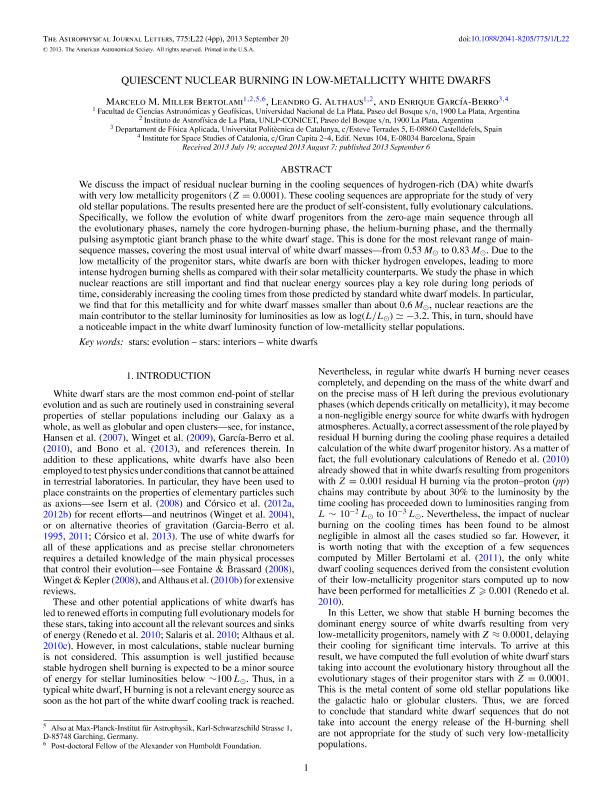Mostrar el registro sencillo del ítem
dc.contributor.author
Miller Bertolami, Marcelo Miguel

dc.contributor.author
Althaus, Leandro Gabriel

dc.contributor.author
Garcia Berro, E.
dc.date.available
2016-11-30T14:29:39Z
dc.date.issued
2013-09
dc.identifier.citation
Miller Bertolami, Marcelo Miguel; Althaus, Leandro Gabriel; Garcia Berro, E.; Quiescent nuclear burning in low-metallicity white dwarfs; IOP Publishing; Astrophysical Journal; 775; 1; 9-2013; 22-26
dc.identifier.issn
2041-8205
dc.identifier.uri
http://hdl.handle.net/11336/8487
dc.description.abstract
We discuss the impact of residual nuclear burning in the cooling sequences of hydrogen-rich (DA) white dwarfs with very low metallicity progenitors (Z = 0.0001). These cooling sequences are appropriate for the study of very old stellar populations. The results presented here are the product of self-consistent, fully evolutionary calculations. Specifically, we follow the evolution of white dwarf progenitors from the zero-age main sequence through all the evolutionary phases, namely the core hydrogen-burning phase, the helium-burning phase, and the thermally pulsing asymptotic giant branch phase to the white dwarf stage. This is done for the most relevant range of main-sequence masses, covering the most usual interval of white dwarf masses—from 0.53 M ☉ to 0.83 M ☉. Due to the low metallicity of the progenitor stars, white dwarfs are born with thicker hydrogen envelopes, leading to more intense hydrogen burning shells as compared with their solar metallicity counterparts. We study the phase in which nuclear reactions are still important and find that nuclear energy sources play a key role during long periods of time, considerably increasing the cooling times from those predicted by standard white dwarf models. In particular, we find that for this metallicity and for white dwarf masses smaller than about 0.6 M ☉, nuclear reactions are the main contributor to the stellar luminosity for luminosities as low as log (L/L ☉) sime –3.2. This, in turn, should have a noticeable impact in the white dwarf luminosity function of low-metallicity stellar populations.
dc.format
application/pdf
dc.language.iso
eng
dc.publisher
IOP Publishing

dc.rights
info:eu-repo/semantics/openAccess
dc.rights.uri
https://creativecommons.org/licenses/by-nc-sa/2.5/ar/
dc.subject
Stellar Evolution
dc.subject
White Dwarfs
dc.subject.classification
Astronomía

dc.subject.classification
Ciencias Físicas

dc.subject.classification
CIENCIAS NATURALES Y EXACTAS

dc.title
Quiescent nuclear burning in low-metallicity white dwarfs
dc.type
info:eu-repo/semantics/article
dc.type
info:ar-repo/semantics/artículo
dc.type
info:eu-repo/semantics/publishedVersion
dc.date.updated
2016-11-18T15:10:54Z
dc.journal.volume
775
dc.journal.number
1
dc.journal.pagination
22-26
dc.journal.pais
Estados Unidos

dc.journal.ciudad
Philadelphia
dc.description.fil
Fil: Miller Bertolami, Marcelo Miguel. Consejo Nacional de Investigaciones Científicas y Técnicas. Centro Científico Tecnológico la Plata. Instituto de Astrofísica de la Plata; Argentina. Universidad Nacional de la Plata. Facultad de Ciencias Astronómicas y Geofísicas; Argentina
dc.description.fil
Fil: Althaus, Leandro Gabriel. Consejo Nacional de Investigaciones Científicas y Técnicas. Centro Científico Tecnológico la Plata. Instituto de Astrofísica de la Plata; Argentina. Universidad Nacional de la Plata. Facultad de Ciencias Astronómicas y Geofísicas; Argentina
dc.description.fil
Fil: Garcia Berro, E.. Universidad Politecnica de Catalunya; España. Institute for Space Studies of Catalonia; España
dc.journal.title
Astrophysical Journal

dc.relation.alternativeid
info:eu-repo/semantics/altIdentifier/url/http://iopscience.iop.org/article/10.1088/2041-8205/775/1/L22/meta
dc.relation.alternativeid
info:eu-repo/semantics/altIdentifier/doi/http://dx.doi.org/10.1088/2041-8205/775/1/L22
Archivos asociados
